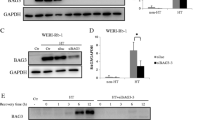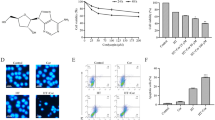Abstract
Hyperthermia induced by heat stress (HS) is known to inhibit proliferation and induce cell death in cancer. We previously demonstrated that checkpoint kinase 1 (Chk1) contributes to G2/M arrest and cell survival under HS; however, the role of Chk2, a functional analog of Chk1, in regulation of the cell cycle and cell death under HS is still unknown. Here, we addressed the role of Chk2 using Molt-4 cells with p53-targeted shRNA (Molt-4/shp53) and parental control cells (Molt-4/V). Chk2 inhibition suppressed C-terminal acetylation of p53 and delayed the induction of p53-target genes in Molt-4/V cells under HS; however, Chk2 inhibition failed to inhibit apoptosis induced by HS, indicating that Chk2 was dispensable for p53-dependent apoptosis under HS. In contrast, Chk2 inhibition abrogated G2/M arrest and promoted cell death induced by HS in HeLa cells and Molt-4/shp53 cells. Thus, we demonstrated for the first time that Chk2 was required for cell cycle arrest and cell survival, particularly in cells with p53 defects under HS. These findings indicated that Chk2 may be a selective target for p53-mutated or -deficient cancer treated with hyperthermia.






Similar content being viewed by others
References
Bettaieb A, Paulina K, Averill-Bates D (2013) Hyperthermia: cancer treatment and beyond. In: Rangel L (ed) Cancer treatment-conventional and innovative approaches. InTechOpen, Rijeka, pp 257–283
Ahmed K, Tabuchi Y, Kondo T (2015) Hyperthermia: an effective strategy to induce apoptosis in cancer cells. Apoptosis 20:1411–1419
Hildebrandt B, Wust P, Ahlers O et al (2010) The cellular and molecular basis of hyperthermia. Crit Rev Oncol 43:33–56
Oei AL, Vriend LEM, Crezee J et al (2015) Effects of hyperthermia on DNA repairpathways: one treatment to inhibit them all. Radiat Oncol 10:165
Takahashi A, Matsumoto H, Nagayama K et al (2004) Evidence for the involvement of double-strand breaks in heat-induced cell killing. Cancer Res 64:8839–8845
Kantidze OL, Velichko AK, Luzhin AV, Razin SV (2016) Heat stress-induced DNA damage. Acta Naturae 8:75–78.
Takahashi A, Ohnishi T (2005) Does gammaH2AX foci formation depend on the presence of DNA double strand breaks? Cancer Lett 229:171–179
Harper JW, Elledge SJ (2007) The DNA damage response: ten years after. Mol Cell 28:739–745
Jackson SP, Bartek J (2009) The DNA-damage response in human biology and disease. Nature 461:1071–1078
Meek DW (2009) Tumour suppression by p53: a role for the DNA damage response? Nat Rev Cancer 9:714–723
Levine AJ, Oren M (2009) The first 30 years of p53: growing ever more complex. Nat Rev Cancer 9:749–758
Zannini L, Delia D, Buscemi G et al (2015) CHK2 kinase in the DNA damage response and beyond. Mol Cell Biol 6:442–457
Hirao A, Cheung A, Duncan G, Girard PM (2002) Chk2 is a tumor suppressor that regulates apoptosis in both an ataxia telangiectasia mutated (ATM)-dependent and an ATM-independent manner. Mol Cell Biol 22:6521–6532
Nam EA, Cortez D (2011) ATR signalling: more than meeting at the fork. Biochem J 436:527–536
Bartek J, Lukas J (2003) Chk1 and Chk2 kinases in checkpoint control and cancer. Cancer Cell 3:421–429
Smith J, Tho LM, Xu N, Gillespie DA (2010) The ATM-Chk2 and ATR-Chk1 pathways in DNA damage signaling and cancer. Adv Cancer Res 108:73–112
Miyakoda M, Suzuki K, Kodama S, Watanabe M (2002) Activation of ATM and phosphorylation of p53 by heat shock. Oncogene 21:1090–1096
Furusawa Y, Iizumi T, Fujiwara Y et al (2012) Inhibition of checkpoint kinase 1 abrogates G2/M checkpoint activation and promotes apoptosis under heat stress. Apoptosis 17:102–112
Tuul M, Kitao H, Iimori M et al (2013) Rad9, Rad17, TopBP1 and claspin play essential roles in heat-induced activation of ATR kinase and heat tolerance. PLoS ONE 8:e55361
Morita A, Yamamoto S, Wang B et al (2010) Sodium orthovanadate inhibits p53-mediated apoptosis. Cancer Res 70:257–265
Furusawa Y, Fujiwara Y, Hassan MA et al (2012) Inhibition of DNA-dependent protein kinase promotes ultrasound-induced cell death including apoptosis in human leukemia cells. Cancer Lett 322:107–112
Morita A, Ariyasu S, Ohya S et al (2013) Evaluation of zinc(II) chelators for inhibiting p53-mediated apoptosis. Oncotarget 4:2439–2450
Furusawa Y, Fujiwara Y, Campbell P et al (2012) DNA double-strand breaks induced by cavitational mechanical effects of ultrasound in cancer cell lines. PLoS ONE 7:e29012
Furusawa Y, Obata Y, Fukuda S et al (2013) Commensal microbe-derived butyrate induces the differentiation of colonic regulatory T cells. Nature 504:446–450
Li P, Zhao Q-L, Jawaid P et al (2017) Enhancement of hyperthermia-induced apoptosis by 5Z-7-oxozeaenol, a TAK1 inhibitor, in Molt-4 cells. Int J Hyperth 22:1–11
Yunoki T, Kariya A, Kondo T et al (2013) The combination of silencing BAG3 and inhibition of the JNK pathway enhances hyperthermia sensitivity in human oral squamous cell carcinoma cells. Cancer Lett 335:52–57
Obata Y, Furusawa Y, Endo TA et al (2014) The epigenetic regulator Uhrf1 facilitates the proliferation and maturation of colonic regulatory T cells. Nat Immunol 15:571–579
Furusawa Y, Zhao Q-L, Hattori Y, et al (2016) Comprehensive and computational analysis of genes in human umbilical vein endothelial cells responsive to X-irradiation. Genom Data 8:126–130
Okazawa S, Furusawa Y, Kariya A et al (2013) Inactivation of DNA-dependent protein kinase promotes heat-induced apoptosis independently of heat-shock protein induction in human cancer cell lines. PLoS ONE 8:e58325
Li P, Furusawa Y, Wei Z-L et al (2013) TAK1 promotes cell survival by TNFAIP3 and IL-8 dependent and NF-κB independent pathway in HeLa cells exposed to heat stress. Int J Hyperth 29:688–695
Takahashi A, Mori E, Ohnishi T (2010) The foci of DNA double strand break-recognition proteins localize with gammaH2AX after heat treatment. J Radiat Res 51:91–95
Takahashi A, Mori E, Su X et al (2010) ATM is the predominant kinase involved in the phosphorylation of histone H2AX after heating. J Radiat Res 51:417–422
Prevo R, Fokas E, Reaper PM et al (2012) The novel ATR inhibitor VE-821 increases sensitivity of pancreatic cancer cells to radiation and chemotherapy. Cancer Biol Ther 13:1072–1081
Nakano H, Kurihara K, Okamoto M et al (1997) Heat-induced apoptosis and p53 in cultured mammalian cells. Int J Radiat Biol 71:519–529
Guan J, Stavridi E, Leeper DB, Iliakis G (2002) Effects of hyperthermia on p53 protein expression and activity. J Cell Physiol 190:365–374
Ohnishi K, Ohnishi T (2001) Heat-induced p53-dependent signal transduction and its role in hyperthermic cancer therapy. Int J Hyperth 17:415–427
Ou Y-H, Chung P-H, Sun T-P, Shieh S-Y (2005) p53 C-terminal phosphorylation by CHK1 and CHK2 participates in the regulation of DNA-damage-induced C-terminal acetylation. Mol Biol Cell 16:1684–1695
Reed S, Quelle D (2015) p53 Acetylation: regulation and Consequences. Cancers 7:30–69
Kastan MB, Bartek J (2004) Cell-cycle checkpoints and cancer. Nature 432:316–323
Donzelli M, Draetta GF (2003) Regulating mammalian checkpoints through Cdc25 inactivation. EMBO Rep 4:671–677
O’Connor MJ (2015) Targeting the DNA damage response in cancer. Mol Cell 60:547–560
Reinhardt HC, Aslanian AS, Lees JA, Yaffe MB (2007) p53-deficient cells rely on ATM- and ATR-mediated checkpoint signaling through the p38MAPK/MK2 pathway for survival after DNA damage. Cancer Cell 11:175–189
Furusawa Y (2016) Cell cycle response to hyperthermia. In: Kokura S (ed) Hyperthermic oncology from bench to bedside. Springer, New York, pp 61–76
Chehab NH, Malikzay A, Stavridi ES, Halazonetis TD (1999) Phosphorylation of Ser-20 mediates stabilization of human p53 in response to DNA damage. Proc Natl Acad Sci USA 96:13777–13782
Ahn J, Urist M, Prives C (2003) Questioning the role of checkpoint kinase 2 in the p53 DNA damage response. J Biol Chem 278:20480–20489
Madlener S, Rosner M, Krieger S et al (2009) Short 42 C heat shock induces phosphorylation and degradation of Cdc25A which depends on p38MAPK, Chk2 and 14.3.3. Hum Mol Genet 18:1990–2000
Bárta T, Vinarský V, Holubcová Z et al (2010) Human embryonic stem cells are capable of executing G1/S checkpoint activation. Stem Cells 28:1143–1152
Peng CY, Graves PR, Thoma RS et al (1997) Mitotic and G2 checkpoint control: regulation of 14-3-3 protein binding by phosphorylation of Cdc25C on serine-216. Science 277:1501–1505
Acknowledgements
This work was supported in part by Uehara Memorial Foundation, Tamura Science and Technology Foundation, and Japanese Society for Thermal Medicine.
Author information
Authors and Affiliations
Corresponding author
Ethics declarations
Conflict of interest
All authors declare that they have no conflict of interest.
Electronic supplementary material
Below is the link to the electronic supplementary material.
Rights and permissions
About this article
Cite this article
Furusawa, Y., Yamanouchi, Y., Iizumi, T. et al. Checkpoint kinase 2 is dispensable for regulation of the p53 response but is required for G2/M arrest and cell survival in cells with p53 defects under heat stress. Apoptosis 22, 1225–1234 (2017). https://doi.org/10.1007/s10495-017-1402-2
Published:
Issue Date:
DOI: https://doi.org/10.1007/s10495-017-1402-2




